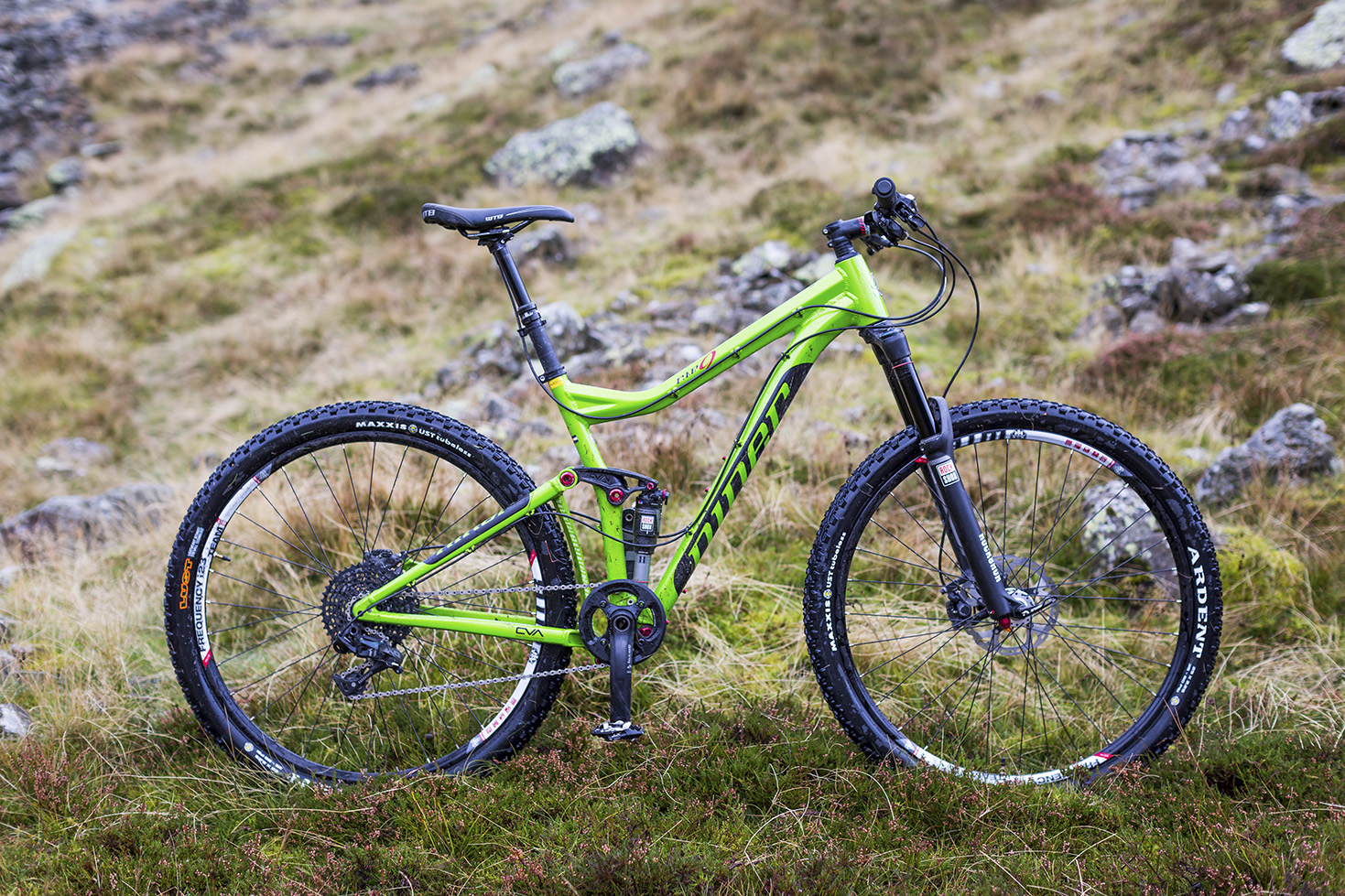The 2014 RIP 9 manages just over 125mm of wheel travel, 10mm more than on the earlier model. A 140mm fork is recommended, but 120mm is fine if you prefer slightly faster handling. You can buy a frame alone for £1,699, or there are various full build options available. The suspension design is the same as on the Jet 9, which has 100mm of travel and is intended for a 120mm fork. Now that we’ve ridden both bikes we can honestly say that the RIP 9’s extra travel doesn’t make any difference to the bike’s climbing prowess, apart from the fact that you’re carrying a little more weight in the frame and fork. If weight saving is a priority there’s a RDO (Race Day Only) carbon version for an extra £1,000 or so, but it only weighs about 300g less than this one.
The CVA (Constantly Varying Arc) suspension design takes advantage of the fact that the bottom bracket centre on a 29in bike is lower than the wheel centres. The main swingarm pivot sits on a linkage underneath the bottom bracket to create a virtual pivot point in front of the crankset and no obvious interference with the suspension motion from pedal power, regardless of which sprockets you’re using. Our test bike was set up with SRAM’s X0 1×11 drivetrain but the frame can also take double rings using a direct mount front mech and has ISCG chain guide tabs. The short head tube is 1.5/1.125in tapered, the bottom bracket is threaded and the dropouts take a 142x12mm bolt-through axle. There are two sets of bottle cage bosses, one of which is underneath the down tube, and cable routing is full length outers all the way, including guides for a dropper seat post. Componentry wise, our test bike came with a RockShox Pike 140mm thru-axle fork, Monarch rear shock and Reverb post. Finishing kit featured Niner’s stem and 780mm bar, Shimano XT brakes, WTB saddle and excellent wheels built with Hope’s (X0 compatible) Pro 2 Evo hubs and WTB Frequency i23 Team rims shod with Maxxis Ardent 2.25in UST treads.
Trail Notes.
We chose these three bikes based on their reputation for pedalling stability as well as their low weight for the amount of plush on offer. We’d say the RIP 9 is the one that’s likely to appeal most to cross-country trail riders. Its shock eating abilities on rough trails are impressive but it’s the rock-solid power predictability on easy trails that stuns. Regardless of its near-30lb weight and 13.5in (static) bottom bracket height, it pedals through big thrill, high velocity trails like a short travel bike. We set up both the shock and fork with about 25% sag for the first ride, then 30% thereafter. At 30% we got full rear wheel travel on big, square-edged hits and pedal clearance through rocky corners, steps and compression dips was never an issue, even with the suspension set soft. Bump absorption is silky smooth and well controlled in the softer settings of the Monarch shock and Pike fork, but the harder settings feel a little more stifled than the medium settings on Fox forks and shocks, which would also cost you a little more.
Niner has accommodated the increasingly aggressive riding aspirations of a lot of those who buy bikes like this, by going slightly slacker in geometry (69.5º head and 72.5º seat angles with a 140mm fork) since earlier models of the RIP 9. But this has by no means interfered with the handling ability of the bike on tamer trails or on climbs. The kinked-forward seat tube and out-of-the-way linkages allow the back end of the frame to be built short enough to noticeably help traction on tricky climbs but there’s still plenty of mud room around the tyre. If you stand up and pedal with a choppy style, there’s obviously more weight shift bobbing in the softer shock setting than when it’s set harder, but there’s no noticeable interaction with the suspension, or back end flex. The laid-back seat tube does mean that getting exactly the right frame size is crucial, or you’ll be sitting too far back or too far forward for optimal pedalling. The medium test bike was ideal for those an inch either side of 5ft 11in, but you’re quickly aware that dropping the seat post shortens the reach from the saddle to the handlebar by slightly more than on a bike with a more vertical seat tube. Still, very impressive, and careful size choice is really the only point of hesitation in otherwise wholehearted praise.
Overall.
The Niner RIP 9 comes in carbon or aluminium framed versions. We’d say it’s one that will appeal most to riders coming from a cross-country background. But it’s designed to take a lot more abuse than the average cross-country trail will hand out. With less rear wheel travel than the Trek or the Intense, plus a noticeably pert back end, it felt the fastest of the three on the climbs and the least lively on twisty singletrack. By ‘least lively’, we mean easiest to ride. Handling was spot on but stability was to the fore, encouraging a relaxed rather than animated riding stance that almost makes you forget you’re on a bike that can take a lot of ‘throw caution to the wind’ moves on the big downs. We’ll mention here too that this was the bike that got the most compliments on its aesthetics during the test.
- Frame // Air-formed aluminium w/130mm RockShox Monarch shock
- Fork // 140mm RockShox Pike
- Hubs // Hope Pro 2 Evo
- Rims // WTB Frequency i23 Team
- Tyres // Maxxis Ardent UST 2.25in
- Chainset // SRAM X0 32t w/Rock RingFront
- Mech // None
- Rear Mech // SRAM X0
- Shifters // SRAM 1×11
- Cassette // 10-42t
- Brakes // Shimano XT w/180/160mm rotors
- Stem // Niner Bars // Niner 780mm low-rise
- Grips // Niner
- Seatpost // RockShox Reverb
- Saddle // WTB Volt
- Size Tested // Medium (18in)
- Sizes Available // S, M, L, XL
- Weight // 29.3lb (13.2kg) without pedals
Review Info
| Brand: | Jungle Products |
| Product: | Niner R.I.P 9 |
| From: | Jungle Products, jungleproducts.co.uk |
| Price: | Price: £4,399 as tested, £1,699 frame only |
| Tested: | by Steve Worland for One month |




